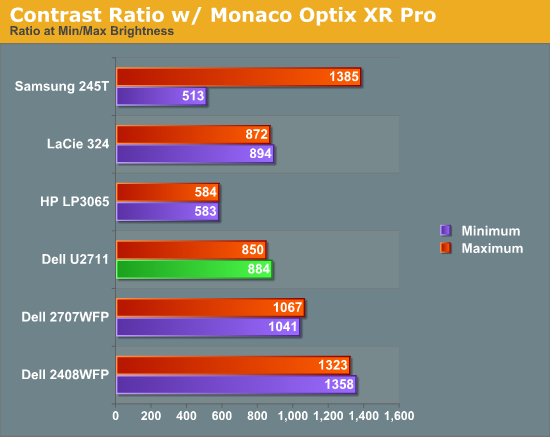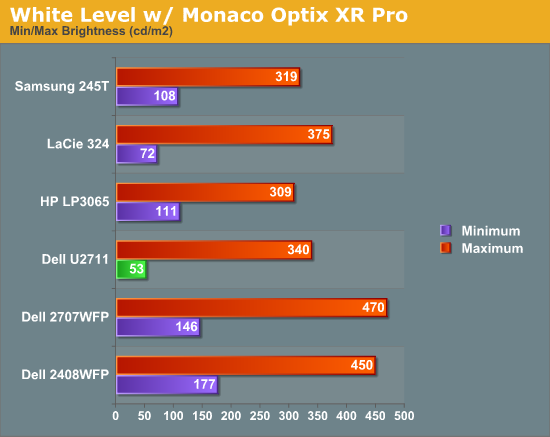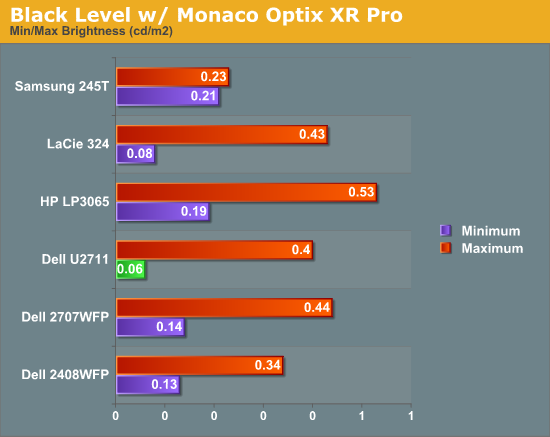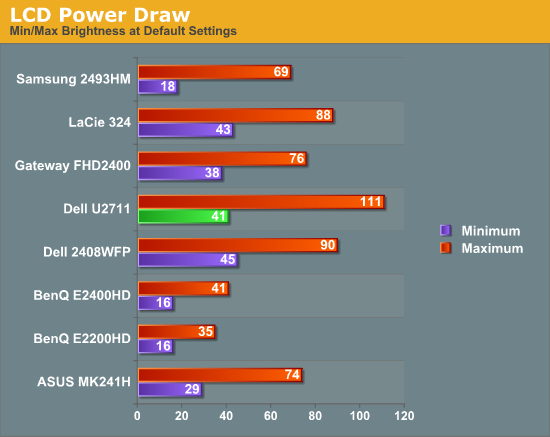Dell UltraSharp U2711: Quality has a Price
by Jarred Walton on January 22, 2010 2:00 AM EST- Posted in
- Displays
Brightness and Contrast
For the brightness, contrast, and color accuracy tests, we depend on a hardware colorimeter and software to help calibrate the displays. We use a Monaco Optix XR (DTP-94) colorimeter and Monaco Optix XR Pro software. Dell advertises a typical contrast ratio of 1000:1 and a maximum contrast (using dynamic backlight adjustment) of 80000:1. We're not interested in dynamic contrast, so we used the Adobe RGB setting for the results below. For those that are wondering, the reason we don't like dynamic contrast is that CCFL backlights take time to settle in and provide a consistent output, and if a display is constantly modifying the backlight level you won't get accurate colors.



Don't pay too much attention to the white/black graphs, as they are merely reference points for how the displays perform at certain settings. Like many other LCDs, the U2711 has a "normal" brightness level of around 260nits (the Adobe RBS setting defaults to 50% brightness and contrast), which is more than sufficient and is actually brighter than what most users prefer to use in an office environment. You can reach the advertised 350nits (give or take) if you max out brightness and contrast.
We're more interested in the contrast ratio, and here we find that the U2711 doesn't quite reach the advertised 1000:1 but instead comes closer to 850:1. We would have liked to see black levels a bit lower to improve the contrast, but really anywhere above 750:1 is difficult to see the difference, and 500:1 is sufficient for most users. At lower brightness settings, the contrast ratio improves to the point where our 100nits "print" result (~13% brightness) actually reached the advertised 1000:1 contrast ratio.
Power Requirements
Going along with the brightness levels, here are the power requirements we measured at the Windows desktop using the minimum brightness (53nits) setting along with 100nits (13%), 200nits (36%), and maximum brightness (340nits).

This is another area where we think the U2711 could be improved, but the cost might be too high right now. CCFL backlighting has been the norm since LCDs first came out, and it works but it's not the most power efficient way of lighting up an LCD. LEDs are the new and improved method, but while they can save power they also tend to deliver a lower color gamut. RGB LEDs address that shortcoming but they cost more and appear to use a similar amount of power compared to CCFL (and we've only seen them used in laptops so far). The U2711 draws a minimum of 41W, but a more realistic setting of 200nits will pull 72W. At maximum brightness the display settles down to 111W, but we measured a peak draw of 124W. (When we first cranked up brightness from 36% to 100%, brightness also reached 390nits before declining to 340nits.) We'd like to see LCDs that deliver all the color quality at half the power draw, but right now it's more a question of priorities: if you go green on power, your green colors may end up lacking. And to keep things in perspective, 72W at 200nits for a 27" LCD is still about half the power of your typical 21/22" CRT running at ~200nits!










153 Comments
View All Comments
Zebo - Friday, January 22, 2010 - link
I only buy NEC after dozens of tries and finally found nirvana on 20wmgx2 and 2490wuxi. I hope NEC comes out with high res 27 like this then I'm in.IMO- Most LCD's tend to look grainy - as in I can see pixels, especially so in the 26/27's current out there. This panel will alleviate much of that.
GTVic - Friday, January 22, 2010 - link
Thanks for the article, there are many people who don't mind spending more for a quality display. 24" 1920x1200 would be my next choice, this is a bit too large/costly if you want multiple displays.My guess is that the 11 in U2711 is distinguishing it from the U2410 which had some issues that are mostly fixed now. Doesn't sound like they will come out with a U2411 or will they?
Affectionate-Bed-980 - Friday, January 22, 2010 - link
If you're gonna compare this monitor, it HAS to be compared against the Dell 2707. I see the 2707 in many of the tests, but not all. WHY? The best candidates to test against are the U2410, 2408, 2707, and even 3008. Why the heck would you be so inconsistent and use only some monitors in some test and different batches in others? Sigh @ anandtech inconsistency. I know you want to use old data and stuff that's available, but when you make these reviews, please consider reviewing against things that matter.... and KEEPING those test candidates in 100% of the time.strikeback03 - Friday, January 22, 2010 - link
Probably depends what tests they were doing when they had that monitor. If it was a test unit sent by Dell they had to send it back, so unless someone bought one of those it is no longer available for all tests.JarredWalton - Friday, January 22, 2010 - link
As far as the monitors you mentioned, the 2707WFP and 2408WFP are in all of the graphs, with the exception of power -- I didn't test that on the 2707WFP way back when. Same goes for input lag testing -- I started that long after my tests of the 2707WFP and 3007WFP. As for the U2410 and the 3008WFP (along with the 3007WFP-HC), I never have tested any of those and thus can't include data for them.The HP LP3065 will perform very similarly to the 3007WFP-HC and 3008WFP (but the 3008 will have more processing lag). For the charts where I limited the results to a few monitors, I specifically chose the monitors in order to show good, high-end offerings that would compete with the U2711. Obviously, I'm limited to what I've tested, so I used the 2408WFP, 2707WFP, HP LP3065, Samsung 245T, and LaCie 324.
Hope that helps... I'd love to provide results for the 2707WFP, but I can't. I could run tests on my 3007WFP (non-HC), but it's failing on me because it's three years old. Not *failing* really, but I've got some definite image persistence problems now (e.g. if I have content open where there's a start green/white vertical area, and then move that image a bit after 10 minutes, I can see an afterimage for at least 30-45 seconds.)
thedeffox - Friday, January 22, 2010 - link
Nice article.I'd be interested in hearing more about deep color selling point of this display. Perhaps it'd be worthy to explore in a future article. Specifically the complete line of components to enable it, and whether there is any noticeable difference.
It sounds like all the parts are out now for the non-pro to use deep color. Windows 7, the GT240 (are there any better gaming cards with DC support?), and a couple LCDs.
araczynski - Friday, January 22, 2010 - link
as a gamer, i'll take my 28" hanns-g for $240 over the "latest and greatest milking scheme" from anyone else.although i can see professional (not pretend professional) photographers being quite excited at this one perhaps.
as a programmer (at work) i'm happy with my 4 other LCD monitors, 24 dell, 20 dell, 19 acer, 18 nec (they still around?).
i think we're at the point of 'them' just trying to milk the lcd technology for every last dollar they can before moving on to the next 'in' thing.
Griswold - Sunday, January 24, 2010 - link
Considering that hanns-g is below average even for the (low) standards of gaming, it doesnt really matter what your opinion on this higher quality product is. Stick to what you know...kmmatney - Saturday, January 23, 2010 - link
As a gamer, I can tell you that the 28" Hanns-G is terrible for gaming. At least if you've ever used something better. I had one for about 2 years, used mostly for work, but I did try to use it for gaming. It is horrible with dark scenes, the top of the screen is darker than the rest (viewing angle limitation) and the contrast was poor. About the only acceptable scenario were bright outdoor games like Farcry. After using my Soyo MVA panel, I could never go back to using the HannsG anymore for gaming. The HannsG was fine for work (I'm a programmer/engineer), but not games.yacoub - Friday, January 22, 2010 - link
"The final potential drawback with the U2711 that we want to discuss is lag. There are actually two types of lag we noticed during testing, and neither one is likely to be a deal breaker if what you're after is high quality image. Processing lag (a.k.a. "input lag") is definitely present, and it appears to be due in part to the digital scaler."Blah. IPS is all about NOT having the input lag PVA panels have. Making an IPS panel that has noticeable input lag means it no longer has one of its biggest benefits.